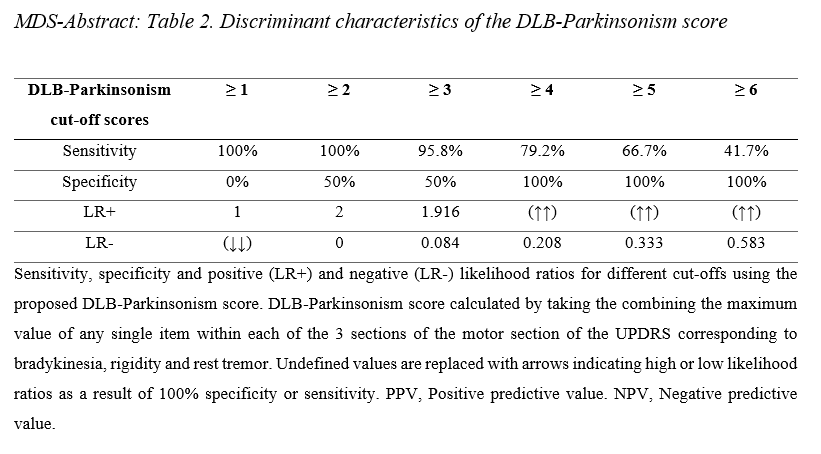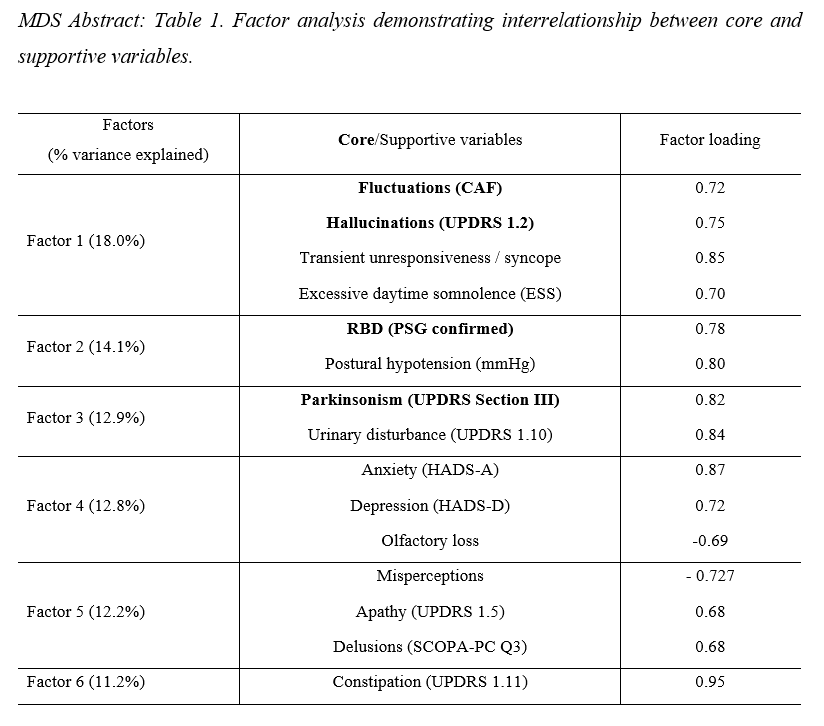Session Information
Date: Wednesday, September 25, 2019
Session Title: Phenomenology and Clinical Assessment of Movement Disorders
Session Time: 1:15pm-2:45pm
Location: Les Muses Terrace, Level 3
Objective: To characterize the interrelationship between core and supportive features of Dementia with Lewy Bodies, and identify optimal methods for their detection to inform better future diagnostic algorithms.
Background: The recent consensus criteria for DLB distinguishes between key core and supportive clinical features to aid diagnosis, yet the relationship between these variables and the optimal methods for detecting them has not been addressed. In this study we assessed all of the core and supportive features in a single cohort. We evaluated the suitability of our assessment battery with respect to cognitive screening tests and core variables and derived symptom clusters to help guide future diagnostic approaches in the clinic.
Method: The clinical and neuropsychological profile of 27 prospectively recruited participants diagnosed with probable DLB and 25 age-matched controls was characterized according to the most recent consensus criteria. Symptoms were scored using a novel combination of established clinical and research instruments.
Results: Prevalence of all core and supportive features were obtained. Factor analysis between all core and supportive features revealed six independent factors accounting for 81.3% of the total variance contributing to diagnosis. Novel relationships within clusters were identified between hallucinations, cognitive fluctuations and excessive daytime somnolence; REM sleep behavior disorder (RBD) and postural hypotension, as well as Parkinsonism and urinary disturbance. Predominantly ‘prodromal’ symptoms including mood and early neuropsychiatric features were represented in the remaining factors. Receiver operator characteristic analysis of cognitive and clinical assessment tools reinforced the MOCA (AUC=0.96; 95%CI: 0.91-1.00) as a suitable screening tool for cognitive impairment with specific subsections correlating strongly (p<0.001) with expected cognitive domains on formal neuropsychometric testing. The potential utility of the UPDRS and RBD screening questionnaire for detecting core features of DLB are discussed and a novel DLB-Parkinsonism scale is proposed to aid diagnosis (AUC=0.94; 95% CI: 0.81 – 1.00).
Conclusion: Identification of latent relationships between core and supportive features and standardized screening methods for their detection are presented. These findings can be used to inform future diagnostic algorithms.
To cite this abstract in AMA style:
E. Matar, K. Ehgoetz Martens, G. Halliday, S. Lewis. Diagnosing Dementia with Lewy Bodies – Characterizing the prevalence and underlying relationships between core and supportive clinical features [abstract]. Mov Disord. 2019; 34 (suppl 2). https://www.mdsabstracts.org/abstract/diagnosing-dementia-with-lewy-bodies-characterizing-the-prevalence-and-underlying-relationships-between-core-and-supportive-clinical-features/. Accessed December 27, 2025.« Back to 2019 International Congress
MDS Abstracts - https://www.mdsabstracts.org/abstract/diagnosing-dementia-with-lewy-bodies-characterizing-the-prevalence-and-underlying-relationships-between-core-and-supportive-clinical-features/


